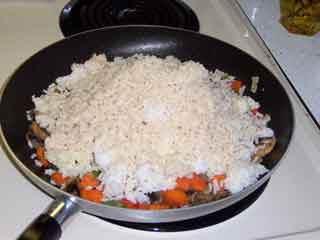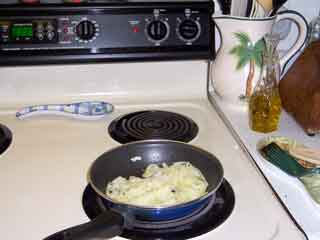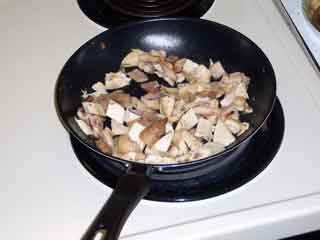Here’s what you need:
leftover rice
chopped up veggies
olive oil (or butter or both)
herbs & spices
maybe some liquid
Tellicherry
Here’s how you do it.
Gather up some leftover rice.

Chop up some veggies.

Heat a pan. Could be a skillet or a saucepan or a dutch oven or a wok or . . . Almost anything will work. Throw in the oil. Swirl. Throw in the veggies. Stir, cook for a while.

Add seasonings (no, not salt – try oregano, or cilantro, or rosemary, or thyme, or basil or . . .). Throw in the rice.

Stir. Cook for a while.

Eat.
Now that you’ve got the hard part down, perhaps a comment or two. You may have noticed that the chopped veggies included some zucchini and summer squash, but the final skillet-full didn’t. Yup. Put in too much rice. Couldn’t fit the rest of the veggies. No worries. Just did them up on the side, in their own pan.

Could’ve tossed everything together to serve, but didn’t that night. Still delicious!

Recently, I’ve done a couple of batches in a big saucepan and experimented with changing the order of cooking and adding the rice.
For example, start out with the pan over moderate heat, add the oil and quickly brown up some chopped onion. Turn the heat down at some point to keep the onion from burning, but do let it get crunchy brown.
Then toss in the rice and stir it all up. In all fried rice approaches, it is important to spend the time to get every kernel of rice coated with the hot oil. So take your time stirring around, turning over, moving from side to side, etc. When you’ve got a nice brown-flecked onion & rice mixture, turn the heat down a little more and let it cook for two or three minutes. You’re trying to let the rice give up the last of its trapped moisture, but to use that moisture as it escapes to tenderize the rice.
Now toss in some mushrooms and stir them around to coat with oil. Add in any long-cooking veggies, like carrots and/or green beans (fresh) and/or celery and/or bell peppers (not that bell peppers require a long time to cook, but they will hold up to it and that lets their flavors spread throughout the dish), and continue to stir around and cook until the mushrooms begin to take on some color.
When the mushrooms start to color, you know that they are about ready to ‘give up their water,’ as the saying goes. And they do contain quite a lot of liquid, which has now cooked enough to take on the delicious flavor of the mushrooms.
So before that liquid releases and evaporates, toss in the remaining quick cooking veggies you might be using – broccoli, summer squash, zucchini, snow peas, bean sprouts, etc. Stir around to coat, add a tiny splash of white wine, and put the lid on. In about five minutes, a 'head of steam’ will have risen under the lid, cooking the last few veggies to perfection and re-moisturizing the rice to tender delectability, and you’ll have created a masterpiece! (No, I don’t have any photos . . .)
Or . . . Start out on low heat, add your oil, and carmelize some carrots. Yup. Just like we did with the onions in the last post, only the carrots won’t take an hour – more like 15 or 20 minutes. But keep them low and slow and turn them over frequently so they don’t burn. Once they start to release their sugars, they become susceptible to burning.
About 10 minutes into the carrot time, toss in some chopped ( ½“ pieces) red and green bell peppers and let them start to carmelize also.
So, now you’re 20 – 25 minutes into the cooking, still low and slow. Toss in the rice and stir to coat with oil. Then add the remaining veggies (including some mushrooms, broccoli, and tomatoes!), hit the pot with a goodly splash or three of Tiparos fish sauce, a tiny splash of white wine, a goodly grind or five of Tellicherry, and slap the lid on.
Give it another 10 – 15 minutes to steam everything into submission, and, well, you’ve done it again!
Or . . .
Hey, you take it from here . . . and enjoy.

















